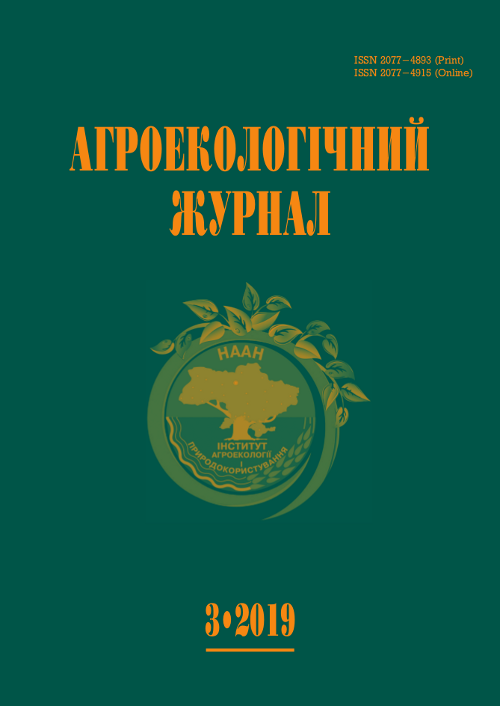Ризоманія – небезпечний вірусний об’єкт для оцінки фіто санітарного стану посівів цукрового буряку України
DOI:
https://doi.org/10.33730/2077-4893.3.2019.183478Ключові слова:
вірус некротичного пожовтіння жилок буряку, ризоманія, ген, патотипАнотація
Проаналізовано результати багаторічних досліджень вірусу некротичного пожовтіння жилок буряку, який спричиняє хворобу ризоманію, що є карантинним об’єктом. Описано молекулярно-біологічні властивості, особливості його геному та залежність патогенезу від генетичних варіацій вірусу. Висвітлено різноманіття патотипів вірусу і циркуляцію хвороби у світі та в Україні зокрема, а також способи її поширення. Проведено аналіз природних генів стійкості рослин цукрового буряку до ризоманії
Посилання
Davarani, F.H., Rezaee, S., Mahmoudi, B. et al. (2014). Detection and molecular characterization of Polymyxa betae, transmitting agent of sugar beet rhizomania disease in Iran. Spanish Journal of Agricultural Research, 12, 3, 787–794 [in English].
Rezende, M., Camelo, V. M., Flores, D.et al. (2015). First Report of Beet necrotic yellow vein virus on Red Table Beet in Brazil. Plant Disease, 99, 3, 423 [in English].
Hrynchuk, K.V., Antipov, I.O., Kyrychenko A.M. et al. (2018). Diahnostyka virusu nekrotychnoho pozhovtinnya zhylok buryaka, shcho tsyrkulyuye v Ukrayini [Diagnosis of beet necrotic yellow vein virus circulating in Ukraine]. Mikrobiolohichnyy zhurnal — Microbiological journal, 80, 1, 77–88 [in Ukrainian].
Hrynchuk, K.V. (2016). Molekulyarna diahnostyka ta identyfikatsiya virusu nekrotychnoho pozhovtinnya zhylok buryaku [Molecular diagnosis and identification of beet necrotic yellow vein virus]. Extended abstract of candidate’s thesis. Kyiv [in Ukrainian].
Brunt, А., Grabtree, K., & Dalwitz, K. et al. (1996). Plant Viruses Online Beet necrotic yellow vein furovirus. pvo.bio-mirror.cn. Retrieved from: http://pvo.bio-mirror.cn/descr086.htm [in English].
Koenig, R. &Tamada, T. (2000). Beet necrotic yellow vein virus. CMI / AAB Descriptions of Plant viruses, 144 [in English].
Putz, C., Pinck, L., & Pinck, M. et al. (1983). Identification of the 3’- and 5’-ends of beet necrotic yellow vein virus RNAs. FEBS Letters, 156, 1, 41–56 [in English].
Fauquet, M.C., Mayo, M.А., & Maniloff, J. et al. (2005). Virus Taxonomy: VIIIth Report of the International Committee on Taxonomy of Viruses. USA: Elsevier [in English].
Richards, K.E., & Tamada, T. (1992). Mapping functions on the multipartite genome of beet necrotic yellow vein virus. Annual Review of Phytopathology, 30, 291–313 [in English].
Bleykasten-Grosshans, С., Guilley, H., & Bouzoubaa, S. et al. (1997). Independent expression of the first two triple gene block proteins of beet necrotic yellow vein virus complements virus defective in the corresponding gene but expression of the third protein inhibits viral cell-to-cell movement. The American Phytopathological Society, 10, 2, 240–246 [in English].
Bleykasten, C., Gilmer D., Guilley, H. et al. (1996). Beet necrotic yellow vein virus 42kDa triple gene block protein binds nucleic acid in vitro. Journal of General Virology, 77, 879–889 [in English].
Tamada, T., Shirako, Y., Abe, H. et al. (1989). Production and pathogenicity of isolates of beet necrotic yellow vein virus with different numbers of RNA components. Journal of General Virology, 70, 3399–3409 [in English].
Chiba, S.M., Miyanishi, M., & Andika, I.B. et al. (2008). Identification of amino acids of the beet necrotic yellow vein virus p25 protein required for induction of the resistance response in leaves of Beta vulgaris plants. Journal of General Virology, 89, 1314–1323 [in English].
Schirmer, A., Link, D., & Cognat, V. et al. (2005). Phylogenetic analysis of isolates of beet necrotic yellow vein virus collected worlwide. Journal of General Virology, 86, 2897–2911 [in English].
D’Alonzo, M., Delbianco, A., Lanzoni, С. et al. (2012). Beet soil-borne mosaic virus RNA-4 encodes a 32 kDa protein involved in symptom expression and in virus transmission through Polymyxa betae. Virology, 423, 2, 87–194 [in English].
Rahim, D., Andika, I.B., & Han, Ch. et al (2007). RNA-4-encoded p31 of beet necrotic yellow vein virus is involved in efficient vector transmission, symptom severity and silencing suppression in roots. Journal of General Virology, 88, 1611–1619 [in English].
Pferdmenges, F. (2007). Occurrence, spread and pathogenicity of different Beet necrotic yellow vein virus (BNYVV) isolates. Doctor`s thesis. Göttingen [in English].
Covellі, L., Klein, E., & Gilmer, D. (2009). The first 17 amino acids of the beet necrotic yellow vein virus RNA5-encoded p26 protein are sufficient to activate transcription i n a yeast one-hybrid system. Archives of Virology, 154, 2, 347–351 [in English].
Lennefors, B.L. (2006). Molecular breeding for resistance to rhizomania in sugar beets. Doctor’s thesis. Uppsala [in English].
Mehvar, M., Valizadah, J., & Koenig, R. et al. (2009). Iranian Beet necrotic yellow vein virus (BNYVV): Pronounced diversity of the p25 coding region in A-type BNYVV and identification of P-type BNYVV lacking a fifth RNA species. Archivesof Virology, 154, 3, 501–506 [in English].
Nurmukhammedov, A.K. (2005). Pidvyshchennya stiykosti tsukrovykh buryakiv do zbudnykiv ryzomaniyi, hnyley koreneplodiv ta koreneyida skhodiv [Increasing the resistance of sugar beet to pathogens of rhizomania, rot of root crops and rooting of seedlings]. Doctor`s thesis. Moscow [in Russian].
Barr, K.J., & Asher, M.C. (1996). Studies on the life-cycle of Polymyxa betae in sugar beet roots. Mycological Research, 100, 2, 203–208 [in Russian].
Manko, O.A. (2003). Ryzomaniya tsukrovykh buryakiv — selektsiya na stiykist [Rhizomania of sugar beet — breeding for stability]. Candidate’s thesis. Kiev [in Ukrainian].
Galein, Y., Legreve, A., & Bragard, C. (2018). Long Term Management of Rhizomania Disease-Insight Into the Changes of the Beet necrotic yellow vein virus RNA-3 Observed Under Resistant and Nonresistant Sugar Beet Field. Front. Plant Sci, 9, 795, 1–15 [in English].
Filipowicz, W., Jaskiewicz, L., & Kolb, F.A. et al. (2005). Posttranscriptional gene silencing by siRNAs and miRNAa. Current Opinion in Structural Biology, 15, 331–341 [in English].
Strausbaugh, C.A., & Eujayl, I.A. (2018). Influence of Beet necrotic yellow vein virus and Freezing Temperatures on Sugar Beet Roots in Storage, 102, 5, 932–937 [in English].
Liu, H., & Lewellen, R.T. (2007). Distribution and molecular characterisation of resistance-breaking isolates of Beet necrotic yellow vein virus in the Unites States. Plant Disease, 91, 7, 847–851 [in English].
Vinogradova, S.V. (2012). Ispol’zovaniye 3’-netransliruyemoy oblasti virusa nekroticheskogo pozhelteniya zhilok svekly v kachestve induktora ustoychivosti k rizomanii [Using of a 3’-untranslated region of the beet necrotic yellow vein virus as an inducer of resistance to rhizomania]. Extended abstract of Candidate’s thesis. Moskva [in Russian].
Beet necrotic yellow vein virus (benyvirus) (2006). European and Miditerranean Plant protection organization (OEPP/EPPO), 36, 3, 429–440 [in English].
##submission.downloads##
Опубліковано
Номер
Розділ
Ліцензія
Авторське право і ліцензування
Умови ліцензії: автори зберігають авторські права і надають журналу право першої публікації з роботою, одночасно ліцензованої за ліцензією Creative Commons Attribution License International CC-BY, яка дозволяє іншим ділитися роботою з визнанням авторства роботи і початкової публікації в цьому журналі.
Якщо стаття прийнята до публікації в «Агроекологічний журнал», автор повинен підписати угоду про передачу авторських прав. Угода відправляється на поштову (оригінал) або адресу електронної пошти (відсканована копія) редакції журналу.
Цією угодою автор підтверджує, що представлені матеріали:
- не порушують авторських прав інших осіб або організацій;
- раніше не публікувались в інших видавництвах і не були представлені для публікації в інших виданнях.
Автор передає редакції «Агроекологічного журналу» права на:
- публікації статті українською (англійською) мовою і поширення її друкованої копії;
- поширення електронної копії статті, а також електронної копії перекладу статті на англійську мову (для статей українською мовою), будь-якими електронними засобами (розміщення на офіційному сайті журналу, електронних баз даних, сховищ тощо) друкована копія перекладу.
Автор залишає за собою право без згоди редакції та засновників:
- Використовувати матеріали статті повністю або частково в ознайомлювальних цілях.
- Використовувати матеріали статті повністю або частково для написання власних дисертацій.
- Використовувати матеріали статті для підготовки тез доповідей, доповідей конференцій, а також усних доповідей.
- Додати електронні копії статті (включаючи остаточну електронну копію, завантажену з офіційного сайту журналу) за адресою:
- персональні веб-ресурси всіх авторів (веб-сайти, веб-сторінки, блоги тощо);
- веб-ресурси установ, в яких працюють автори;
- некомерційні веб-ресурси відкритого доступу (наприклад, arXiv.org).
У всіх випадках наявність бібліографічного посилання на статтю або гіперпосилання на її електронну копію на офіційному сайті журналу є обов'язковим.



